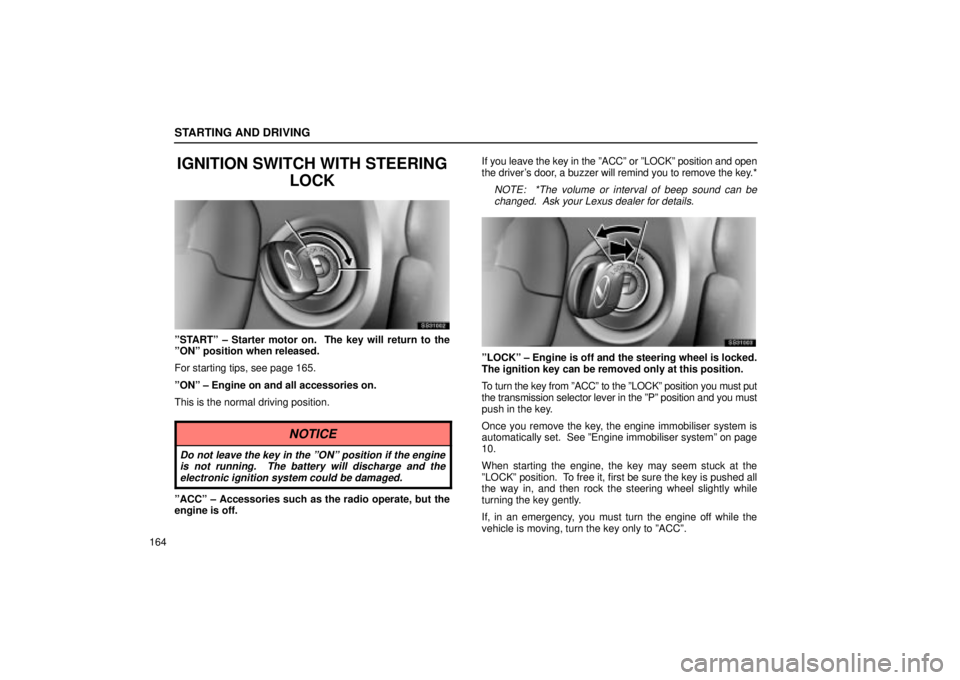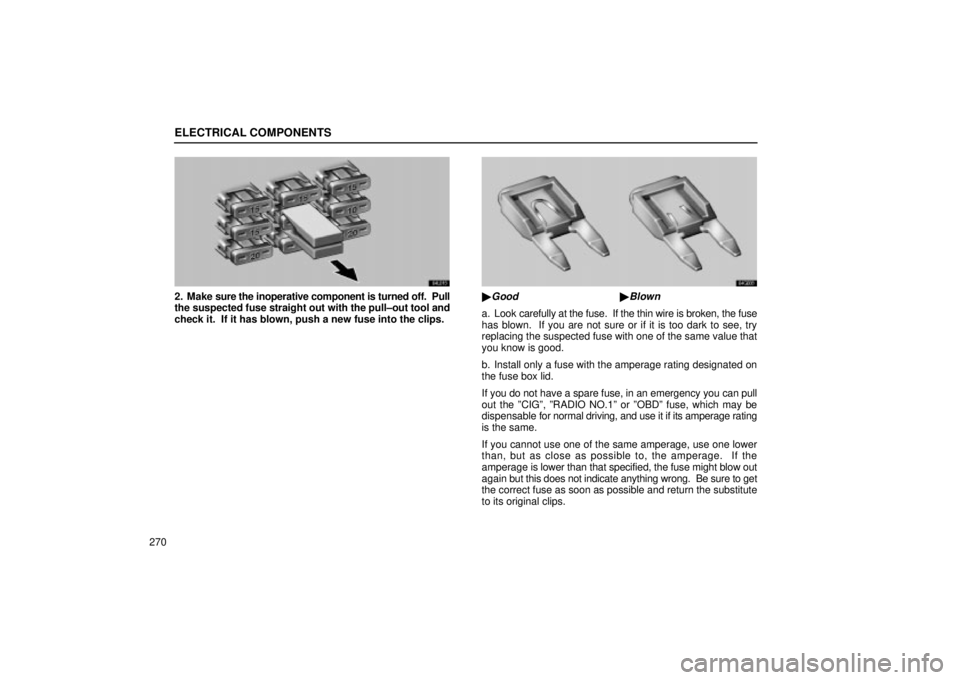Page 168 of 301

AUDIO
155
(h) If the player malfunctions
If the player or another unit equipped with the player
malfunctions, your audio system will display one of the four
following error messages.
If ºERR 1º appears on the display:
It indicates that the disc
is dirty, damaged, or it was inserted up±side down. Clean the
disc or insert it correctly.
If ºERR 3º or ºERR 4º appears on the display: It indicates
there is a trouble inside the system. Eject the disc.
If the malfunction is not rectified: Take your vehicle to your
Lexus dealer.
Car audio system operating hints
NOTICE
To ensure the correct audio system operation:
�Be careful not to spill beverages over the audio system.
�Do not put anything other than a cassette tape orcompact disc into the cassette tape slot or compact
disc slot.
�The use of cellular phone inside or near the vehiclemay cause a noise from the speakers of the audiosystem which you are listening to. However, thisdoes not indicate a malfunction.
Radio reception
Usually, the problem with radio reception does not mean there
is a problem with your radio ± it is just the normal result of
conditions outside the vehicle.
For example, nearby buildings and terrain can interfere with
FM reception. Power lines or telephone wires can interfere
with AM signals. And of course, radio signals have a limited
range. The farther you are from a station, the weaker its signal
will be. In addition, reception conditions change constantly as
your vehicle moves.
Here are some common reception problems that probably do
not indicate a problem with your radio:
Page 169 of 301

AUDIO
156FM
Fading and drifting stations
± Generally, the effective range
of FM is about 40 km (25 miles). Once outside this range, you
may notice fading and drifting, which increase with the
distance from the radio transmitter. They are often
accompanied by distortion.
Multi±path ± FM signals are reflective, making it possible for
two signals to reach your antenna at the same time. If this
happens, the signals will cancel each other out, causing a
momentary flutter or loss of reception.
Static and fluttering ± These occur when signals are blocked
by buildings, trees, or other large objects. Increasing the bass
level may reduce static and fluttering.
Station swapping ± If the FM signal you are listening to is
interrupted or weakened, and there is another strong station
nearby on the FM band, your radio may tune in the second
station until the original signal can be picked up again. AM
Fading
± AM broadcasts are reflected by the upper
atmosphere ± especially at night. These reflected signals can
interfere with those received directly from the radio station,
causing the radio station to sound alternately strong and weak.
Station interference ± When a reflected signal and a signal
received directly from a radio station are very nearly the same
frequency, they can interfere with each other, making it dif ficult
to hear the broadcast.
Static ± AM is easily affected by external sources of electrical
noise, such as high tension power lines, lightening, or electrical
motors. This results in static.
Page 177 of 301

STARTING AND DRIVING
164
IGNITION SWITCH WITH STEERINGLOCK
SS31002
ºSTARTº ± Starter motor on. The key will return to the
ºONº position when released.
For starting tips, see page 165.
ºONº ± Engine on and all accessories on.
This is the normal driving position.
NOTICE
Do not leave the key in the ºONº position if the engine
is not running. The battery will discharge and theelectronic ignition system could be damaged.
ºACCº ± Accessories such as the radio operate, but the
engine is off. If you leave the key in the ºACCº or ºLOCKº position and open
the driver's door, a buzzer will remind you to remove the key.*
NOTE: *The volume or interval of beep sound can be
changed. Ask your Lexus dealer for details.
SS31003
ºLOCKº ± Engine is off and the steering wheel is locked.
The ignition key can be removed only at this position.
To turn the key from ºACCº to the ºLOCKº position you must put\
the transmission selector lever in the ºPº position and you must
push in the key.
Once you remove the key, the engine immobiliser system is
automatically set. See ºEngine immobiliser systemº on page
10.
When starting the engine, the key may seem stuck at the
ºLOCKº position. To free it, first be sure the key is pushed all
the way in, and then rock the steering wheel slightly while
turning the key gently.
If, in an emergency, you must turn the engine off while the
vehicle is moving, turn the key only to ºACCº.
Page 276 of 301

ELECTRICAL COMPONENTS
264
No.FUSEAMPERECIRCUIT
1 D FR P/W20Power window system
2 TAIL10Tail lights, Side marker lights,
License plate lights,
Parking lights
3 GAUGE10
Back±up lights, Power window,
Gauges and meters,
Service reminder indicators and
buzzers,
Emergency flashers,
Windshield defogger,
Outside rear view mirror
defogger
4 DOOR20Door lock system
5 PANEL7.5
Instrument panel lights,
Seat heater, Cigarette lighter,
Automatic transmission system,
Traction control system,
Rear fog light, Ashtray light
6 WASHER15Windshield washer,
Headlight cleaner
7 STARTER7.5Starting system
8 FR DEF20No circuit
9 A/C10Air conditioning system
10 SEAT HTR15Seat heater
11 CIG15Cigarette lighter, Power outlet
12 S/ROOF30Moon roof
No.FUSEAMPERECIRCUIT
13 ECU±IG10
Radiator fan,
Anti±lock brake system,
Moon roof, Shift lock system,
Air conditioning system,
Door lock system,
Headlight beam level control,
Theft deterrent system
14 SRS±ACC10SRS system
15 STOP15Stop lights, Shift lock system,
Anti±lock brake system
16 WIPER25Windshield wipers
17 RADIONO.210Audio, Air conditioning,
Outside rear view mirror,
Shift lock system
18 D P/SEAT30Power seat system
19 DOME7.5
Interior lights, Trunk light,
Vanity lights,
Ignition switch light, Map light,
Door courtesy lights
20 FR FOG15Fog lights
21 P FR P/W20Power window system
22 TV7.5Television
23 ECU±B27.5Theft deterrent system,
Door lock system
24 D RR P/W20Power window system
25 MIR HTR15Outside rear view mirror
Page 277 of 301

ELECTRICAL COMPONENTS
265
No.FUSEAMPERECIRCUIT
26 MPX±B10
Power window system,
Air conditioning,
Gauges and meters,
Theft deterrent system
27 P RR P/W20Power window system
28 SRS±B7.5SRS system, Door lock system
29 P P/SEAT30Power seat system
30 OBD7.5On±board diagnosis system
31 IGN7.5
SRS system,
Multiport fuel injection
system/sequential multiport fuel
injection system,
Cruise control system
32 ECU±B120
Theft deterrent system,
Door lock system,
Interior light, Trunk light,
Vanity light, Ignition switch light,
Map light, Door courtesy lights,
Power window system,
Air conditioning,
Gauges and meters
33 ALT±S7.5Charging system
34 ETCS15Electronic throttle control
system
35 AM220
Starting system, SRS system,
Multiport fuel injection
system/sequential multiport fuel
injection system, Cruise control
system
36 HORN10Horn
No.FUSEAMPERECIRCUIT
37 TEL7.5Telephone
38 RADIONO.120Audio
39 TURN±HAZ15Turn signal lights
40 EFI25
Multiport fuel injection
system/sequential multiport fuel
injection system,
Emission control system,
Engine immobiliser system
41 DRL NO.230Daytime running light system
42 DRL NO.17.5Daytime running light system
43 H±LP L LW R15Left±hand headlight
(low beam), Fog lights
44 H±LP R LW R15Right±hand headlight
(low beam)
45 SPARESpare fuse
46 SPARESpare fuse
47 SPARESpare fuse
48 H±LP LUPR10Left±hand headlight
(high beam)
49 H±LP R UPR10
Right±hand headlight
(high beam),
Service reminder indicators and
buzzers
Page 282 of 301

ELECTRICAL COMPONENTS
270
64L013
2. Make sure the inoperative component is turned off. Pull
the suspected fuse straight out with the pull±out tool and
check it. If it has blown, push a new fuse into the clips.
64G008
�Good�Blown
a. Look carefully at the fuse. If the thin wire is broken, the fuse
has blown. If you are not sure or if it is too dark to see, try
replacing the suspected fuse with one of the same value that
you know is good.
b. Install only a fuse with the amperage rating designated on
the fuse box lid.
If you do not have a spare fuse, in an emergency you can pull
out the ºCIGº, ºRADIO NO.1º or ºOBDº fuse, which may b\
e
dispensable for normal driving, and use it if its amperage rating
is the same.
If you cannot use one of the same amperage, use one lower
than, but as close as possible to, the amperage. If the
amperage is lower than that specified, the fuse might blow out
again but this does not indicate anything wrong. Be sure to get
the correct fuse as soon as possible and return the substitute
to its original clips.
Page:
< prev 1-8 9-16 17-24